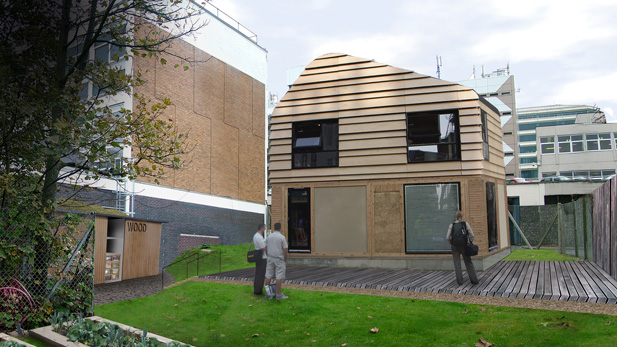As I prepare for my cross-country road trip from Boston to California, one thing I'll have to pack is plenty of food. Of course, my trip won't require too much planning in that area, because I'll be staying on this planet. But when it comes to sending humans to Mars, a Ziploc of trail mix and a few tubes of Pringles won't suffice--after all, astronauts sailing through space on their way to Mars won't be able to pull over at Burger King and grab a medium number one, no pickles.
So, how exactly are astronauts supposed to maintain a healthy diet while traveling such a long journey? And what will they eat once they settle down on the Red Planet? Food in space has come a long way since John Glenn, of Project Mercury, tucked in to his small aluminum packages of foods and liquids. Today, astronauts on the International Space Station enjoy a variety of canned, packaged, and freeze dried goods, various condiments for enhanced flavor and drinks like juice to coffee.
 Dinner is served at the Johnson Space Center food lab. Image courtesy NASA.
|
Adapting food for a space flight was one challenge. But if astronauts are to stay on Mars for an extended period of time, they won't be able to bring enough food with them. They'll need to grow it. On Mars.
Mars' environment is starkly different from Earth's. The surface pressure on Mars is roughly 1/100th of that on Earth. Temperatures range between -200 to 80 degrees Fahrenheit. Greenhouses--known as "food production units" at NASA--have to be carefully designed to fend off Mars's harsh conditions while still nurturing healthy plants. Martian farmers will also need to imitate the wide variety of growing environments found on Earth. Certain crops may need a high humidity environment, while others like vegetables such as squash or tomatoes may not.
To test out the techniques future explorers might use to farm on Mars, scientists at the Kennedy Space Center are experimenting with growing lettuce and peas in low-pressure greenhouses. Why low pressure? As Robert Ferl, director of the Interdisciplinary Center for Biotechnology Research at the University of Florida, explains, low-pressure units are easier to transport to and build on Mars. Plus, at low pressure, plants soak up and release water faster, allowing for speedy recycling of limited quantities of water that are available within the dome while also inhibiting hormones such as ethylene which could cause fruits and vegetables to quickly ripen and rot.
Private companies are investigating Mars agriculture, too. Mars One, which has set out the ambitious goal of settling humans on Mars by 2023, intends to feed the colonists using Plant Production Units that control temperature, light, and humidity, allowing plants to thrive despite the harsh conditions outside. They are essentially closed rooms with beds of plants situated beneath rows of colored LED lights, explains Gertjan Meeuws, a managing partner at Plant Lab, the company that manufactures the units. The LEDs generate light in red, blue, and a nearly-invisible color called far-red, a spectrum which is optimal for photosynthesis. The units also control the air temperature and disperse water on a timer.
These units weren't originally designed for Mars, but were created to feed Earth's growing population. Because they can be placed directly in cities, says Meeuws, they cut out many of the traditional steps of food production and transportation, qualities that will also be important on Mars.
No matter what kind of structure Mars crops are grown in, though, they will need water. Mars is drier than the Sahara, so according to Ferl, the key to maintaining a strong water supply will be recycling. Astronauts managing the growth operations must make sure all water that escapes into the atmosphere is later condensed so that it can be reused, either by the astronauts themselves or to water plants in the closed greenhouse system.
Yet Mars is not totally dry. Subsurface water ice could be mined for drinking and for watering crops. Or, if humans settle far from these natural water sources, they might be able to synthesize water using hydrogen and oxygen locked up in nearby rocks.
Growing crops on an alien planet is just one of the challenges. Preparing these crops is another. Food scientists from Cornell University are working to create menus for HI-SEAS, a simulated Mars mission slated to begin in early 2013. Using a remote lava field 8,500 feet up a mountain in Hawaii as a stand-in for Mars, the 120 day simulated mission will focus on how to feed human settlers using the limited resources they have. Space flight experts recognize the psychological importance of a diverse meal schedule, explains Cornell biological engineer Jean Hunter, so one of the main goals of the simulation is to create an outer space menu that will prevent "menu fatigue."
So on my way to California, as my fingers brush the bottom of that bag of trail mix and I start hankering for a bag of Cheetos, I will keep in mind that my menu fatigue is nothing compared to what future Mars astronauts will have to manage. All I know is that when I get to California I am there to stay, and I hope I survive being away from Red Sox fans and jaywalkers. As I stop at the Grand Canyon and look up to the sky, I can now be assured that my fellow humans who choose to delve into our vast galaxy will be well prepared and well fed and as they embark on the adventure of expanding human life on another planet.
Learn more about Mars on NOVA's Ultimate Mars Challenge, premiering Wednesday, November 14 at 9 pm ET on most PBS stations. Please check your local listings to confirm when it will air near you.
















Recent Comments